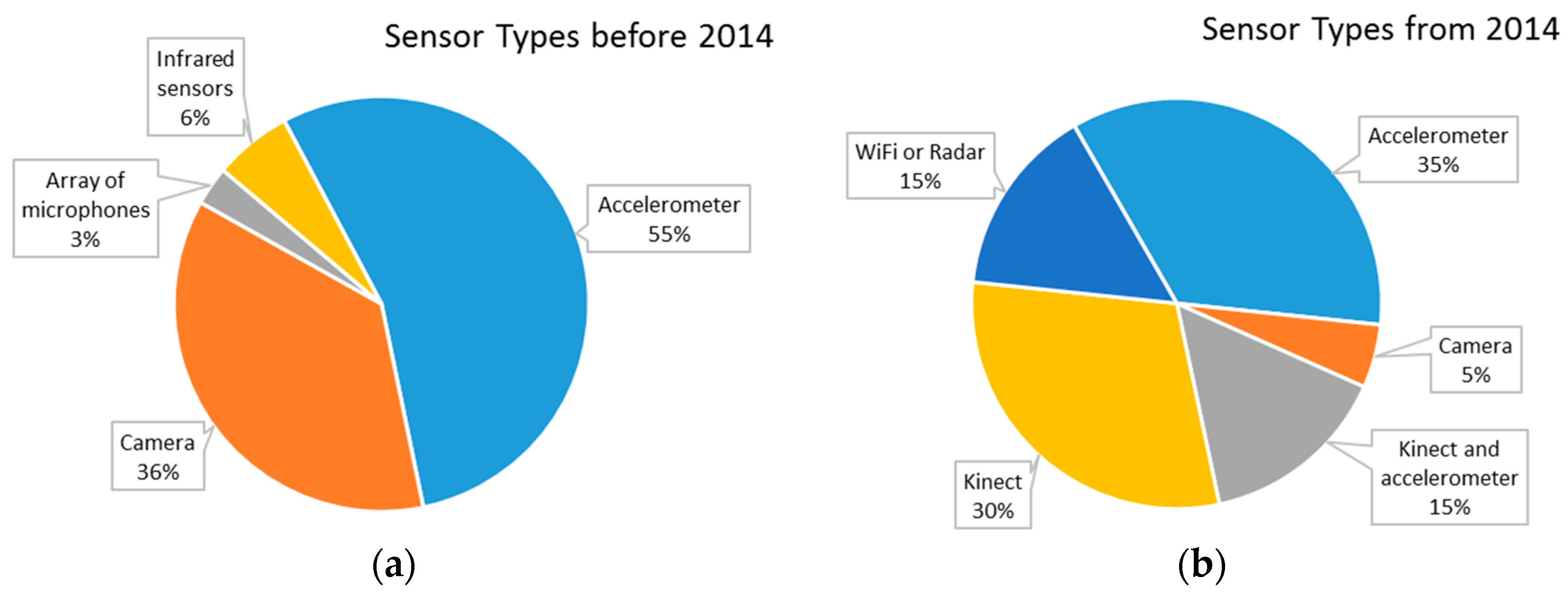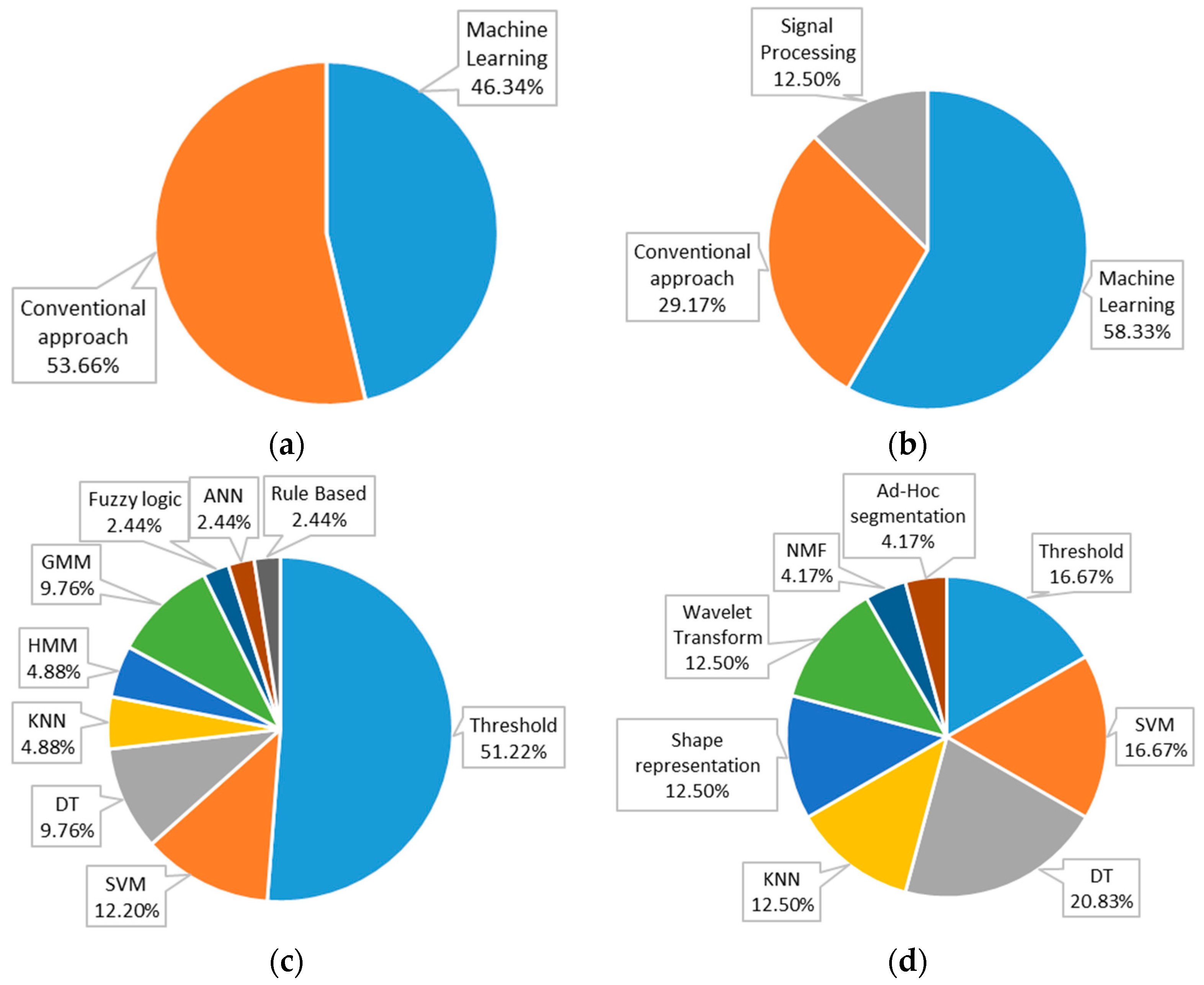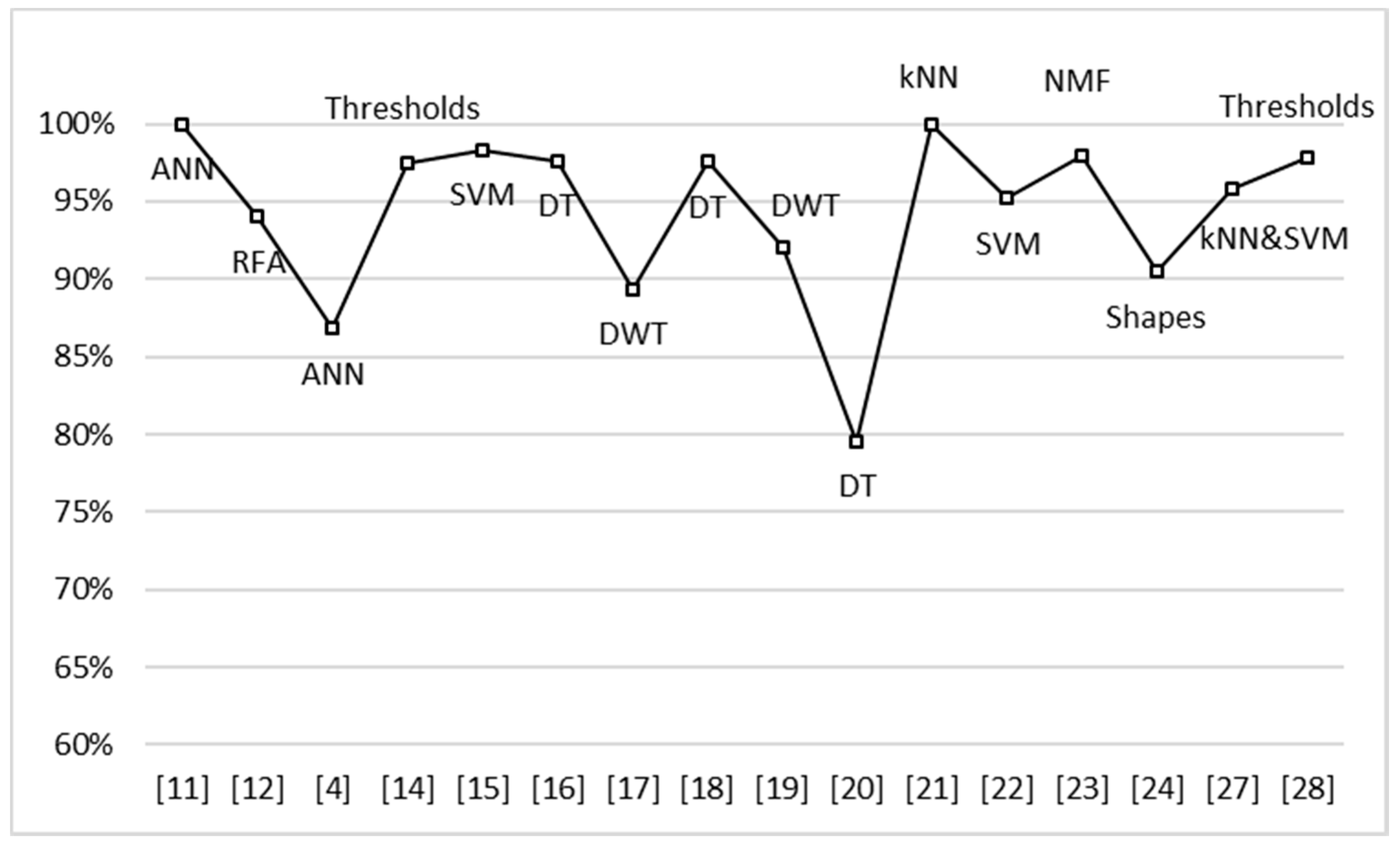New Advances and Challenges of Fall Detection Systems: A Survey
Abstract
1. Introduction
2. The Related Work on Prior Surveys
3. Bird’s Eye View of Fall Detection Research from 2014
3.1. Evolution of Sensors
3.2. Changes of Fall Detection Algorithms
3.3. Performances of Fall Detection Systems
4. Challenges and Potentials
4.1. How to Define the Fall Based on Universal Features
4.2. How to Apply the Theories and System to Reality
4.3. How to Protect Privacy
4.4. How to Move on from Detection to Prediction
5. Conclusions
- Revolution of sensors: Depth camera, especially the Kinect, has been widely used; RF sensors, such as Wi-Fi, appear on the stage of fall detection.
- Changes of algorithms: Machine learning becomes the mainstream in fall detection, but feature extraction does not have an obvious innovation.
- Performance of system: Accuracy remains at the high level; however, it is still far from becoming a practical application.
- How to define the fall based on universal features
- How to apply this study to practice
- How to protect privacy
- How to from detection to prediction
Acknowledgments
Author Contributions
Conflicts of Interest
References
- WHO: Falls. Available online: http://www.who.int/mediacentre/factsheets/fs344/en/ (accessed on 25 December 2017).
- Igual, R.; Medrano, C.; Plaza, I. Challenges, issues and trends in fall detection systems. Biomed. Eng. OnLine 2013, 12, 66. [Google Scholar] [CrossRef] [PubMed]
- Bagalà, F.; Becker, C.; Cappello, A.; Chiari, L.; Aminian, K.; Hausdorff, J.M.; Zijlstra, W.; Klenk, J. Evaluation of accelerometer-based fall detection algorithms on real-world falls. PLoS ONE 2012, 7, e37062. [Google Scholar] [CrossRef] [PubMed]
- Ma, X.; Wang, H.; Xue, B.; Zhou, M.; Ji, B.; Li, Y. Depth-Based Human Fall Detection via Shape Features and Improved Extreme Learning Machine. IEEE J. Biomed. Health Inform. 2014, 18, 1915–1922. [Google Scholar] [CrossRef] [PubMed]
- Noury, N.; Fleury, A.; Rumeau, P.; Bourke, A.K.; Laighin, G.O.; Rialle, V.; Lundy, J.E. Fall detection—Principles and Methods. In Proceedings of the 2007 29th Annual International Conference of the IEEE Engineering in Medicine and Biology Society, Lyon, France, 22–26 August 2007; pp. 1663–1666. [Google Scholar]
- Mubashir, M.; Shao, L.; Seed, L. A survey on fall detection: Principles and approaches. Neurocomputing 2013, 100, 144–152. [Google Scholar] [CrossRef]
- Habib, M.A.; Mohktar, M.S.; Kamaruzzaman, S.B.; Lim, K.S.; Pin, T.M.; Ibrahim, F. Smartphone-Based Solutions for Fall Detection and Prevention: Challenges and Open Issues. Sensors 2014, 14, 7181–7208. [Google Scholar] [CrossRef] [PubMed]
- Perry, J.T.; Kellog, S.; Vaidya, S.M.; Youn, J.H.; Ali, H.; Sharif, H. Survey and evaluation of real-time fall detection approaches. In Proceedings of the 2009 6th International Symposium on High Capacity Optical Networks and Enabling Technologies (HONET), Alexandria, Egypt, 28–30 December 2009; pp. 158–164. [Google Scholar]
- Delahoz, Y.S.; Labrador, M.A. Survey on Fall Detection and Fall Prevention Using Wearable and External Sensors. Sensors 2014, 14, 19806–19842. [Google Scholar] [CrossRef] [PubMed]
- Stone, E.E.; Skubic, M. Fall Detection in Homes of Older Adults Using the Microsoft Kinect. IEEE J. Biomed. Health Inform. 2015, 19, 290–301. [Google Scholar] [CrossRef] [PubMed]
- Mastorakis, G.; Makris, D. Fall detection system using Kinect’s infrared sensor. J. Real Time Image Process. 2014, 9, 635–646. [Google Scholar] [CrossRef]
- Wang, Y.; Wu, K.; Ni, L.M. WiFall: Device-Free Fall Detection by Wireless Networks. IEEE Trans. Mob. Comput. 2017, 16, 581–594. [Google Scholar] [CrossRef]
- Gasparrini, S.; Cippitelli, E.; Spinsante, S.; Gambi, E. A Depth-Based Fall Detection System Using a Kinect® Sensor. Sensors 2014, 14, 2756–2775. [Google Scholar] [CrossRef] [PubMed]
- Wang, J.; Zhang, Z.; Li, B.; Lee, S.; Sherratt, R.S. An enhanced fall detection system for elderly person monitoring using consumer home networks. IEEE Trans. Consum. Electron. 2014, 60, 23–29. [Google Scholar] [CrossRef]
- Kwolek, B.; Kepski, M. Human fall detection on embedded platform using depth maps and wireless accelerometer. Comput. Methods Programs Biomed. 2014, 117, 489–501. [Google Scholar] [CrossRef] [PubMed]
- Bian, Z.P.; Hou, J.; Chau, L.P.; Magnenat-Thalmann, N. Fall Detection Based on Body Part Tracking Using a Depth Camera. IEEE J. Biomed. Health Inform. 2015, 19, 430–439. [Google Scholar] [CrossRef] [PubMed]
- Su, B.Y.; Ho, K.C.; Rantz, M.J.; Skubic, M. Doppler Radar Fall Activity Detection Using the Wavelet Transform. IEEE Trans. Biomed. Eng. 2015, 62, 865–875. [Google Scholar] [CrossRef] [PubMed]
- Aguiar, B.; Rocha, T.; Silva, J.; Sousa, I. Accelerometer-based fall detection for smartphones. In Proceedings of the 2014 IEEE International Symposium on Medical Measurements and Applications (MeMeA), Lisboa, Portugal, 11–12 June 2014; pp. 1–6. [Google Scholar]
- Kau, L.J.; Chen, C.S. A Smart Phone-Based Pocket Fall Accident Detection, Positioning, and Rescue System. IEEE J. Biomed. Health Inform. 2015, 19, 44–56. [Google Scholar] [CrossRef] [PubMed]
- Castillo, J.C.; Carneiro, D.; Serrano-Cuerda, J.; Novais, P.; Fernández-Caballero, A.; Neves, J. A multi-modal approach for activity classification and fall detection. Int. J. Syst. Sci. 2014, 45, 810–824. [Google Scholar] [CrossRef]
- Kepski, M.; Kwolek, B. Fall detection using ceiling-mounted 3D depth camera. In Proceedings of the 2014 International Conference on Computer Vision Theory and Applications (VISAPP), Lisbon, Portugal, 5–8 January 2014; Volume 2, pp. 640–647. [Google Scholar]
- Pierleoni, P.; Belli, A.; Palma, L.; Pellegrini, M.; Pernini, L.; Valenti, S. A High Reliability Wearable Device for Elderly Fall Detection. IEEE Sens. J. 2015, 15, 4544–4553. [Google Scholar] [CrossRef]
- Li, Y.; Ho, K.C.; Popescu, M. Efficient Source Separation Algorithms for Acoustic Fall Detection Using a Microsoft Kinect. IEEE Trans. Biomed. Eng. 2014, 61, 745–755. [Google Scholar] [CrossRef] [PubMed]
- Chua, J.-L.; Chang, Y.C.; Lim, W.K. A simple vision-based fall detection technique for indoor video surveillance. Signal Image Video Process. 2015, 9, 623–633. [Google Scholar] [CrossRef]
- Amin, M.G.; Zhang, Y.D.; Ahmad, F.; Ho, K.C.D. Radar Signal Processing for Elderly Fall Detection: The future for in-home monitoring. IEEE Signal Process. Mag. 2016, 33, 71–80. [Google Scholar] [CrossRef]
- Lee, J.K.; Robinovitch, S.N.; Park, E.J. Inertial Sensing-Based Pre-Impact Detection of Falls Involving Near-Fall Scenarios. IEEE Trans. Neural Syst. Rehabil. Eng. 2015, 23, 258–266. [Google Scholar] [CrossRef] [PubMed]
- Kwolek, B.; Kepski, M. Improving fall detection by the use of depth sensor and accelerometer. Neurocomputing 2015, 168, 637–645. [Google Scholar] [CrossRef]
- Liu, J.; Lockhart, T.E. Development and Evaluation of a Prior-to-Impact Fall Event Detection Algorithm. IEEE Trans. Biomed. Eng. 2014, 61, 2135–2140. [Google Scholar] [CrossRef] [PubMed]
- Shen, R.K.; Yang, C.Y.; Shen, V.R.L.; Chen, W.C. A Novel Fall Prediction System on Smartphones. IEEE Sens. J. 2017, 17, 1865–1871. [Google Scholar] [CrossRef]
- Wang, H.; Zhang, D.; Wang, Y.; Ma, J.; Wang, Y.; Li, S. RT-Fall: A Real-Time and Contactless Fall Detection System with Commodity WiFi Devices. IEEE Trans. Mob. Comput. 2017, 16, 511–526. [Google Scholar] [CrossRef]
- Tong, L.; Song, Q.; Ge, Y.; Liu, M. HMM-Based Human Fall Detection and Prediction Method Using Tri-Axial Accelerometer. IEEE Sens. J. 2013, 13, 1849–1856. [Google Scholar] [CrossRef]
- Tao, X.; Yun, Z. Fall prediction based on biomechanics equilibrium using Kinect. Int. J. Distrib. Sens. Netw. 2017, 13. [Google Scholar] [CrossRef]
- Xu, T.; Zhou, Y. Elders’ fall detection based on biomechanical features using depth camera. Int. J. Wavelets Multiresolut. Inf. Process. 2018. [Google Scholar] [CrossRef]



| Reference | Sensors | Algorithms | Accuracy | Counts of Citations | Time |
|---|---|---|---|---|---|
| Stone and Skubic [10] | Kinect | Decision Tree (DT) | N/A | 195 | 2015 |
| Mastorakis and Makris [11] | Kinect | Threshold and Shape Features | 100% | 191 | 2014 |
| Wang et al. [12] | Wi-Fi | Random Forest Algorithm (RFA) | 94% | 122 | 2017 |
| Gasparrini et al. [13] | Kinect | Ad-Hoc Segmentation | N/A | 83 | 2014 |
| Ma et al. [4] | Kinect | Shape Features and Artificial Neural Networks (ANN) | 86.83% | 65 | 2014 |
| Wang et al. [14] | Accelerometer | Thresholds | 97.5% | 59 | 2014 |
| Kwolek and Kepski [15] | Accelerometer and Kinect | Support Vector Machine (SVM) | 98.33% | 57 | 2014 |
| Bian et al. [16] | Kinect | Decision tree (DT) | 97.60% | 55 | 2015 |
| Su et al. [17] | Doppler Radar | Discrete Wavelet Transform (DWT) | 89.37% | 49 | 2015 |
| Aguiar et al. [18] | Accelerometer | Decision Tree (DT) | 97.55% | 46 | 2014 |
| Kau et al. [19] | Accelerometer | Discrete Wavelet Transform (DWT) | 92% | 44 | 2015 |
| Castillo et al. [20] | Accelerometers and Video cameras | Decision tree (DT) | 79.57% | 43 | 2014 |
| Kwolek and Kepski [21] | Kinect and Accelerometer | k-Nearest Neighbor (kNN) | 100% | 40 | 2014 |
| Pierleoni et al. [22] | Accelerometer | Support Vector Machine (SVM) | 95.19% | 40 | 2015 |
| Li et al. [23] | Kinect | Nonnegative Matrix Factorization (NMF) | 98% | 38 | 2014 |
| Chua et al. [24] | Video cameras | Shape Features | 90.50% | 35 | 2015 |
| Amin et al. [25] | Doppler Radar | Discrete Wavelet Transform (DWT) and Support Vector Machine (SVM) | N/A | 34 | 2016 |
| Lee et al. [26] | Accelerometer | Thresholds | N/A | 33 | 2015 |
| Kwolek and Kepski [27] | Kinect and Accelerometer | k-Nearest Neighbor (kNN) and Support Vector Machine (SVM) | 95.77% | 31 | 2015 |
| Liu and Lockhart [28] | Accelerometer | Thresholds | 97.83% | 31 | 2015 |
© 2018 by the authors. Licensee MDPI, Basel, Switzerland. This article is an open access article distributed under the terms and conditions of the Creative Commons Attribution (CC BY) license (http://creativecommons.org/licenses/by/4.0/).
Share and Cite
Xu, T.; Zhou, Y.; Zhu, J. New Advances and Challenges of Fall Detection Systems: A Survey. Appl. Sci. 2018, 8, 418. https://doi.org/10.3390/app8030418
Xu T, Zhou Y, Zhu J. New Advances and Challenges of Fall Detection Systems: A Survey. Applied Sciences. 2018; 8(3):418. https://doi.org/10.3390/app8030418
Chicago/Turabian StyleXu, Tao, Yun Zhou, and Jing Zhu. 2018. "New Advances and Challenges of Fall Detection Systems: A Survey" Applied Sciences 8, no. 3: 418. https://doi.org/10.3390/app8030418
APA StyleXu, T., Zhou, Y., & Zhu, J. (2018). New Advances and Challenges of Fall Detection Systems: A Survey. Applied Sciences, 8(3), 418. https://doi.org/10.3390/app8030418





